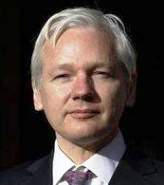In principle an international platform from which activists could collaborate and discuss various issues and plan actions is a good idea but the current model reeks of the 'man' attempting to locate and net the growing hacktivist army of INVISIBLE/ANONYMOUS hackers -- it is this group that really has the man on the ropes so every effort will be made to locate and capture rogue crewz, solos and groups -- be aware and beware!

glamour boy anti-hacker, Assange
It seems like a good idea but things are not always what they seem.
Consider for instance the proposed mapping or LOCATING feature and its connection to smartphones -- already monitored by the man -- and you get the picture, NAILED!
Few elite hackers and no Uber hackers would go near this phishing net project.
WikiLeaks is beginning to show its petticoat, the proposed project stinks!
Do better next time, won't you?
[What a lame attempt to net anonymous crewz and solos! Besides, we already have a global tube network using existing protos, morons!]
Story from PC World follows:
Activist-backed Online Collaboration Platform Due for Release in March
by John Ribeiro, IDG News
The Global Square, an online global collaboration platform for activists backed by WikiLeaks among others, plans to have a functional prototype by March, its sponsors said.
Styled on social networks like Facebook and Twitter, The Global Square, targeted at activists and the global community, will be developed around Tribler peer-to-peer technology.
By using this particular existing P2P technology it becomes virtually impossible to break or censor the network, The Global Square said in a statement earlier this week. "The content files are not centralized in any physical server, so the network belongs to its users," it said.
The project has called for volunteer coders and developers to help implement the features planned for the new platform, which will be open-source and multilingual.
WikiLeaks said in November that The Global Square would be an online platform for its movement.
Some activists said last year that there was a need for a global square "where people of all nations can come together as equals to participate in the coordination of collective actions and the formulation of common goals and aspirations".
Some of the tools for the platform will be an interactive map that lists all ongoing assemblies around the world, search options allowing users to find squares, events, and working-groups, an aggregated news feed, a public and private messaging system, and a forum for public debate and voting on specific decisions.
The project will start with a standalone PC application followed by a smartphone application later in the year. The team will use the Agile software development methodology, focusing on one feature or module for a few weeks, conduct tests, and do a release, and then focus on the next feature.
© 2012 PCWorld Communications, Inc.
http://tinyurl.com/7gbacco

by Taylor Armerding via lynx 2012-02-16 09:01:02
A 20-year-old hacker who goes by the Internet name TinKode was arrested recently by Romanian police after he bragged about hacking into Pentagon and NASA computer systems.
Razvan Manole Cernaianu is accused of revealing security holes and publishing information about SQL injection vulnerabilities in those agencies.
The Romanian Directorate for Investigating Organized Crime and Terrorism said Cernaianu also offered a computer program on his blog that could be used to hack into websites and published a video showing Internet attacks he had made against the U.S. government.
The FBI and NASA assisted in the investigation. The U.S. Embassy in Bucharest said Cernaianu used, "advanced hacking tools to gain unauthorized access to government and commercial systems."
Cernaianu allegedly hacked into a computer server at NASA's Goddard Space Flight Center last April, and posted a screen grab that showed files connected to confidential satellite data.
Anthony M. Freed, managing editor of Infosec Island, says that TinKode is known to have taken advantage of several well-known vulnerabilities that many of his targets should have resolved before he exploited them through SQL injections -- a technique many security experts now derisively call "Hacking 101."
"His targets tend to be large entities that undoubtedly have complex network deployments and multiple interfaces for third parties like contractors or client bases," says Freed, "which provide a higher product probability of his finding unprotected points of entry."
Freed says penetration by a determined hacker is almost guaranteed in networks of this size.
"They should focus on detection and data protection within the networks," he says, "while working under the assumption that they will not be able to prevent all breach attempts.
"Advanced monitoring systems, appropriate data classification, and secondary authentication protocols for access to the most sensitive information is critical both for detecting an intrusion and slowing hackers progress. This can buy the needed time to lock down the compromised system and prevent data theft."
Gary McGraw, CTO of Cigital, says if TinKode didn't want to get caught, he should not have been bragging so publicly. "If you go looking for attention, you're probably going to get it," he says.
McGraw says the damage caused was probably minor. "But, to get past all of these silly problems, agencies like these should build systems with security in mind in the first place. Right now they are trying to fix broken systems."
© 2012 CXO Media Inc.
http://tinyurl.com/6wbpb34